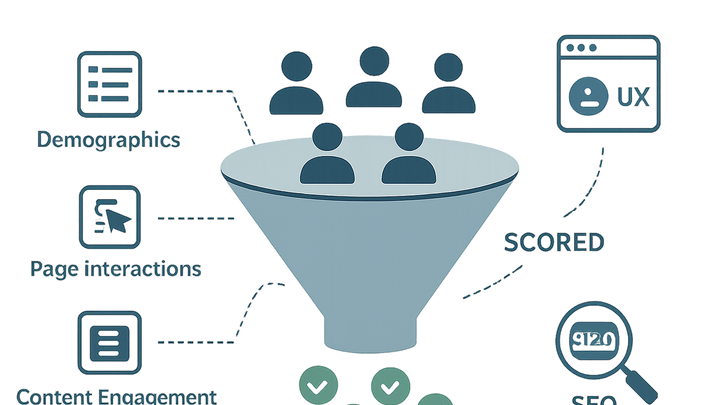Published on 2025-06-29T19:57:06Z
What is Lead Scoring? Examples for Lead Scoring
Lead scoring is the process of assigning numerical values to potential customers (leads) based on predefined criteria such as demographics, behaviors, and engagement signals. In the context of website optimization for CRO, UX, and SEO, it allows teams to prioritize high-value visitors who are most likely to convert. By analyzing actions like page views, form submissions, content downloads, and referral sources, marketers build a scoring model that reflects their unique goals. Tools such as Prevue.me can enrich this process by providing actionable critiques—ranging from accessibility improvements to UX tweaks—that feed into your lead score. Beyond Prevue.me, platforms like HubSpot and Salesforce offer built-in lead scoring features that integrate seamlessly with CRM systems. A robust lead scoring framework streamlines resource allocation, aligns sales and marketing efforts, and accelerates your conversion funnel by focusing on the most promising prospects.
Lead scoring
Lead scoring ranks prospects by demographics and behavior to focus CRO, UX, and SEO efforts on the most promising visitors.
Overview of Lead Scoring
Understanding why lead scoring matters lays the foundation for prioritizing marketing and sales activities. This section explores the core objectives and tangible benefits of implementing a scoring model in a CRO/UX/SEO context.
-
Purpose of lead scoring
Assigns a numerical value to each lead to rank prospects by likelihood to convert, enabling teams to focus on high-impact engagements.
-
Benefits for cro/ux/seo
Helps refine website optimizations by identifying which user journeys, design changes, and content updates yield the highest-scoring leads.
- Improved conversion focus:
Directs A/B tests and UX tweaks toward segments with the greatest revenue potential.
- Enhanced user experience:
Highlights friction points for high-value visitors, guiding targeted UX improvements.
- Optimized seo funnel:
Reveals which organic search terms and landing pages attract the most qualified prospects.
- Improved conversion focus:
Key Components of a Lead Scoring Model
A robust lead scoring framework combines multiple data dimensions. Here we break down the primary scoring categories and common metrics used to evaluate leads.
-
Demographic scoring
Evaluates firmographics and personal attributes to assess fit against your ideal customer profile.
- Company size & industry:
Scores leads higher if they match target sectors or revenue bands.
- Job title & role:
Prioritizes decision-makers or budget holders within an organization.
- Company size & industry:
-
Behavioral scoring
Tracks on-site actions that signal buying intent or sustained interest.
- Page visits & depth:
Higher scores for repeated visits and deep navigation into service or pricing pages.
- Content downloads:
Downloads of whitepapers, eBooks, or case studies add to the lead’s score.
- Page visits & depth:
-
Engagement scoring
Measures interactions across channels, including email, chat, and webinars.
- Email opens & clicks:
Frequent engagement with email campaigns indicates active interest.
- Webinar & event attendance:
Participation in live events suggests a readiness to move further down the funnel.
- Email opens & clicks:
Implementing Lead Scoring with SaaS Tools
Choosing the right platform determines how easily you can automate, adjust, and act on lead scores. This section reviews popular SaaS options and integration tips.
-
Prevue.me
Leverages CRO, UX, SEO, and accessibility critiques to generate custom scoring attributes. Automatically flags high-priority leads based on site performance improvements.
-
Hubspot
Offers built-in lead scoring with drag-and-drop rule creation. Integrates seamlessly with marketing automation and CRM workflows.
-
Salesforce pardot
Enables advanced scoring and grading models, plus AI-powered Einstein Lead Scoring for predictive ranking.
Best Practices and Common Pitfalls
Even well-designed lead scoring systems require ongoing governance. Learn the dos and don’ts to maintain accuracy and alignment between marketing and sales.
-
Align sales and marketing
Establish shared definitions for MQLs and SQLs to ensure leads transition smoothly and sales accepts high-score handoffs.
-
Regularly review and adjust criteria
Monitor scoring performance against closed-won deals and refine weightings to reflect market changes.
-
Avoid over-scoring noise
Exclude trivial actions (e.g., social follows) that inflate scores without indicating genuine intent.
